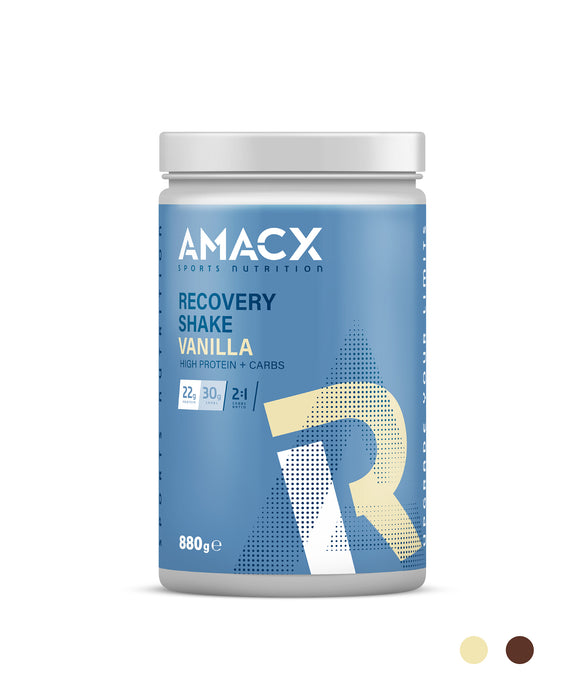
Amacx Recovery Shake
Shipping costs for orders under €50

After an intense road cycling session, proper recovery is crucial for improving performance, avoiding injuries, and achieving long-term progress. But what does effective recovery look like? Here are the best tips for optimal recovery after road cycling training.
Von Lukas Vogt |
3 minutes read time

Your body needs time to recover after every exertion. During training, micro-injuries occur in the muscles, glycogen stores are depleted, and the nervous system is stressed. Without adequate recovery, the risk of overload, reduced performance, and injury increases.
Cooldown: Roll out gently
An abrupt end to your workout can lead to muscle stiffness and circulatory problems. Therefore, roll out at a low intensity for 5-10 minutes to slowly calm your circulation and flush out metabolic waste.
Rehydrate: Compensate for fluid losses
You lose a lot of fluids and electrolytes during exercise. Drink 500 ml to 1 liter of water or an isotonic drink immediately after your workout to quickly replenish your stores.
Replenish energy: The right diet
After training, your body is especially receptive to nutrients. A mix of carbohydrates and proteins (3:1 or 4:1 ratio) helps replenish glycogen stores and support muscle recovery. Suitable snacks include:

Active regeneration: gentle movement
Light exercise like walking or stretching helps stimulate blood circulation and accelerate the removal of metabolic waste products. Even a short yoga session can relieve tension.
Use massage and fascia roll
A gentle massage or the use of a fascia roller can help reduce muscle soreness and accelerate recovery.
Sleep as a superpower
High-quality sleep is the best recovery booster. Your body repairs itself during deep sleep phases. Make sure you stay in a dark, quiet environment and avoid caffeine in the evening.
Compression for faster regeneration
Compression clothing has established itself as another aid during the recovery phase. Wearing special compression garments such as socks, sleeves, or shorts improves blood flow to the muscles, accelerating the removal of metabolic waste products such as lactate. The improved circulation helps reduce swelling and relieve muscle soreness.
Compression can also help reduce muscle fatigue, allowing you to feel ready to perform faster. It's recommended to wear compression clothing for 1 to 2 hours after training to support recovery.
Consciously plan rest periods
Recovery doesn't necessarily mean doing nothing at all. A gentle, low-intensity workout (e.g., a recovery ride) or cross-training, such as on a rowing machine or a trainer, can help increase blood flow to the muscles without putting too much strain on them again.
Keep an eye on nutrition
Focus on a nutrient-rich diet with plenty of vegetables, healthy fats, and adequate protein. Omega-3 fatty acids from fish or flaxseed have anti-inflammatory effects and support regeneration.
Don't forget mental relaxation
Your mind also needs rest. Relaxation techniques such as meditation or breathing exercises can help reduce stress and speed up recovery.
A recovery ride on a road bike is an excellent way to actively support regeneration. This is a deliberately relaxed, low-intensity session – usually between 45 and 60 minutes. The goal is to gently stimulate the circulation, promote blood flow to the muscles, and thus accelerate the removal of metabolic waste products such as lactate.
Important: Your heart rate should stay low, ideally in the recovery zone. Relaxed rides like these often work wonders if you want to loosen up your legs after an intense week of training or a race. Instead of complete rest, a recovery ride on your road bike can be just the thing to help you get back to full performance faster – provided you really keep up the pace.
Without adequate recovery, you won't get the most out of your training. With a conscious recovery strategy, you can return to performance faster and make long-term progress. Give your body the breaks it needs – and you'll emerge stronger!

Wenn Du regelmäßig auf dem Rennrad sitzt, weißt Du, wie wichtig Regeneration ist. Wer hart trainiert, muss dem Körper auch die Chance geben, sich zu erholen. Während viele zu Proteinshakes oder Magnesium greifen, gerät ein natürliches Produkt zunehmend in den Fokus von Ausdauersportlern: Montmorency Sauerkirschsaft.

Anyone who looks around the peloton or at a local race quickly notices: Clean-shaven legs are not an exception in road cycling; they're practically the norm. But why? Is it just about aesthetics, or does shaving your legs actually offer measurable benefits? And if so, how many watts do you really save?

Wer regelmäßig mit dem Rennrad unterwegs ist, kennt das Ritual: Nach einer langen Ausfahrt oder vor einem knackigen Intervalltraining führt kein Weg am Espresso vorbei. Ob in der italienischen Bar an der Strecke, auf dem Marktplatz nach dem Sonntagstraining oder zuhause aus der Siebträgermaschine – der Espresso ist fester Bestandteil der Rennradkultur. Doch was steckt hinter dieser Verbindung aus Koffein, Stil und Leistung?